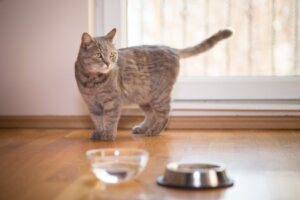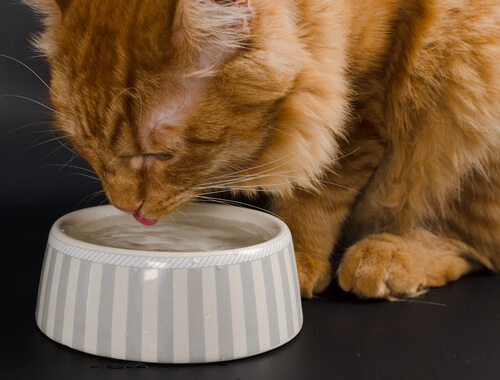My Cat Doesn't Drink Water, What Can I Do?


Written and verified by the veterinarian and zootechnician Sebastian Ramirez Ocampo
Compared to other animal species, cats don’t need to drink as much water. They inherited this trait from their ancestors, the desert cats, who could endure certain periods without drinking water. However, these felines obtained almost all the water they needed for their survival from their prey. The meat supplied all their hydration needs (70% of the meat was water). So, what should you do if your cat doesn’t drink water?
Nowadays, it isn’t common for domesticated cats to hunt rodents, birds, or small lizards, as most of them don’t move outside their homes. For this reason, a constant source of hydration is necessary to prevent the development of dehydration-related diseases in these small felines.
What could happen if my cat doesn’t drink water?
A cat that is fed strictly on concentrate or dry food will need to drink between 220 and 250 ml of water, while if it’s fed wet food, 30 to 50 ml per day is enough. Although these animals can endure more than 24 hours without drinking, due to the low content of this liquid in concentrated food, cats should always have water at their disposal.
If your pet goes for longer without drinking water, they could have serious problems, and you could see clear signs of dehydration such as lethargy, depression, loss of appetite and decreased skin elasticity. Similarly, urinary tract diseases such as stones, kidney failure, cystitis, urethral obstructions, among other disorders, could develop.

Why doesn’t my cat want to drink water?
There are many factors that could cause a cat to refuse to drink water from its bowl. However, most of these situations can be corrected and you’ll prevent your pet from getting dehydrated. Among the main reasons for a cat not wanting to drink are the following:
- Plastic containers: Generally, drinking bowls made of this material give a certain taste to the water that cats don’t usually like. Their preference is for those made of metal or glass.
- Water that is dirty or not fresh: Cats are picky about both their food and their drinking water. These little felines will always opt for a cleaner, clearer, and fresher water, so if the water has been sitting in the bowl for a few days, they will tend to reject it.
- Location of the water bowl: Believe it or not, this is a very important aspect for the cat when it comes to drinking water. Generally, these pets will want you to place their container in a quiet place where they can drink water and feel safe. Ideally, it should be their own drinking fountain and they shouldn’t have to share it with other animals in the home.
- Food: If your cat usually hunts prey, or if you feed it with wet food, its hydration needs may be covered. Because of this, it won’t be looking for water from its bowl or anywhere else.
- Diseases: If you notice that your cat isn’t drinking water normally, and doesn’t want to eat either, then it may be due to some illness. Sometimes there are certain diseases or conditions, such as problems in the mouth or general diseases such as internal organ disease, that would make a cat not want to drink water. In these cases, we recommend that you make an appointment for a check-up with your vet.
What can I do to solve it?

Given the importance of water consumption for your cat, you shouldn’t overlook it if it doesn’t seem to be drinking very much. There are several steps we can take to stimulate our cat’s water consumption. Some strategies include the following:
- Choose a bowl or container preferably made of metal. It should be wide, shallow and located in a quiet area.
- Change the water in the drinking bowl once or twice a day to keep it clean and fresh.
- Place several containers throughout your home. According to several studies, this strategy will increase your cat’s water intake by up to 11%.
- Use drinking bowls and water fountains specially designed for cats. According to several articles, drinking fountains also stimulate water consumption, since the liquid is kept fresh and in constant movement, which is attractive to the cat.
- Try mixing their concentrated food with a little water, or combine their dry food with a can or sachet of wet food.
- Offer several types of water – bottled, boiled or tap water. Similarly, according to a study called “Effects of a nutrient-enriched water or water intake and indices of hydration in healthy domestic cats fed a dry kibble diet,” this nutrient-enriched liquid can increase consumption and hydration levels in pets.
Finally, remember the importance of always keeping your cat hydrated. You can try any of the above strategies to increase your pet’s water intake. If none of these have worked for you, you should have your pet checked by a veterinarian to determine the cause of their low water intake.
Compared to other animal species, cats don’t need to drink as much water. They inherited this trait from their ancestors, the desert cats, who could endure certain periods without drinking water. However, these felines obtained almost all the water they needed for their survival from their prey. The meat supplied all their hydration needs (70% of the meat was water). So, what should you do if your cat doesn’t drink water?
Nowadays, it isn’t common for domesticated cats to hunt rodents, birds, or small lizards, as most of them don’t move outside their homes. For this reason, a constant source of hydration is necessary to prevent the development of dehydration-related diseases in these small felines.
What could happen if my cat doesn’t drink water?
A cat that is fed strictly on concentrate or dry food will need to drink between 220 and 250 ml of water, while if it’s fed wet food, 30 to 50 ml per day is enough. Although these animals can endure more than 24 hours without drinking, due to the low content of this liquid in concentrated food, cats should always have water at their disposal.
If your pet goes for longer without drinking water, they could have serious problems, and you could see clear signs of dehydration such as lethargy, depression, loss of appetite and decreased skin elasticity. Similarly, urinary tract diseases such as stones, kidney failure, cystitis, urethral obstructions, among other disorders, could develop.

Why doesn’t my cat want to drink water?
There are many factors that could cause a cat to refuse to drink water from its bowl. However, most of these situations can be corrected and you’ll prevent your pet from getting dehydrated. Among the main reasons for a cat not wanting to drink are the following:
- Plastic containers: Generally, drinking bowls made of this material give a certain taste to the water that cats don’t usually like. Their preference is for those made of metal or glass.
- Water that is dirty or not fresh: Cats are picky about both their food and their drinking water. These little felines will always opt for a cleaner, clearer, and fresher water, so if the water has been sitting in the bowl for a few days, they will tend to reject it.
- Location of the water bowl: Believe it or not, this is a very important aspect for the cat when it comes to drinking water. Generally, these pets will want you to place their container in a quiet place where they can drink water and feel safe. Ideally, it should be their own drinking fountain and they shouldn’t have to share it with other animals in the home.
- Food: If your cat usually hunts prey, or if you feed it with wet food, its hydration needs may be covered. Because of this, it won’t be looking for water from its bowl or anywhere else.
- Diseases: If you notice that your cat isn’t drinking water normally, and doesn’t want to eat either, then it may be due to some illness. Sometimes there are certain diseases or conditions, such as problems in the mouth or general diseases such as internal organ disease, that would make a cat not want to drink water. In these cases, we recommend that you make an appointment for a check-up with your vet.
What can I do to solve it?

Given the importance of water consumption for your cat, you shouldn’t overlook it if it doesn’t seem to be drinking very much. There are several steps we can take to stimulate our cat’s water consumption. Some strategies include the following:
- Choose a bowl or container preferably made of metal. It should be wide, shallow and located in a quiet area.
- Change the water in the drinking bowl once or twice a day to keep it clean and fresh.
- Place several containers throughout your home. According to several studies, this strategy will increase your cat’s water intake by up to 11%.
- Use drinking bowls and water fountains specially designed for cats. According to several articles, drinking fountains also stimulate water consumption, since the liquid is kept fresh and in constant movement, which is attractive to the cat.
- Try mixing their concentrated food with a little water, or combine their dry food with a can or sachet of wet food.
- Offer several types of water – bottled, boiled or tap water. Similarly, according to a study called “Effects of a nutrient-enriched water or water intake and indices of hydration in healthy domestic cats fed a dry kibble diet,” this nutrient-enriched liquid can increase consumption and hydration levels in pets.
Finally, remember the importance of always keeping your cat hydrated. You can try any of the above strategies to increase your pet’s water intake. If none of these have worked for you, you should have your pet checked by a veterinarian to determine the cause of their low water intake.
All cited sources were thoroughly reviewed by our team to ensure their quality, reliability, currency, and validity. The bibliography of this article was considered reliable and of academic or scientific accuracy.
- Robbins MT, Cline MG, Bartges JW, Felty E, Saker KE, Bastian R, et al. Quantified water intake in laboratory cats from still, free-falling and circulating water bowls, and its effects on selected urinary parameters. Journal of feline medicine and surgery. 2019;21(8):682-90.
- Zanghi BM, Gerheart L, Gardner CL. Effects of a nutrient-enriched water on water intake and indices of hydration in healthy domestic cats fed a dry kibble diet. American journal of veterinary research. 2018;79(7):733-44.
- Grant DC. Effect of water source on intake and urine concentration in healthy cats. Journal of feline medicine and surgery. 2010;12(6):431-4.
- Finco DR, Adams DD, Crowell WA, Stattelman AJ, Brown SA, Barsanti JA. Food and water intake and urine composition in cats: influence of continuous versus periodic feeding. American journal of veterinary research. 1986;47(7):1638-42.
This text is provided for informational purposes only and does not replace consultation with a professional. If in doubt, consult your specialist.








